La guía más completa de conducción y alquiler de coches en Canadá.
Speed Limit and Traffic Signs
Driving in Canada is on the right with overtaking on the left. Since winter weather conditions may make driving challenging, we strongly advise you to check the weather conditions before travelling and be well equipped. Do not also forget to save emergency numbers in your cell phone.
 Speed Limit
Speed LimitUnlike its neighbour, Canada uses metric units. Distance and speed are marked in kilometres and kilometres/hour. There is a speed limit of 50 km/h in town and 80 km/h on highways. A typical speed limit for the freeway in most provinces is 100-110 km/h.
 Traffic Signs
Traffic SignsNotably, for the most parts, Canadian traffic signs employ two languages-- English, French or both, and some incorporate indigenous language such as “Cree”. There are basically 4 types of Canadian traffic signs: regulatory, warning, information and direction.
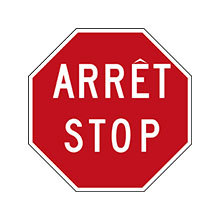 Stop Sign (French and English)
Stop Sign (French and English)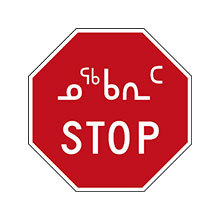 Stop Sign (Inuktitut and English)
Stop Sign (Inuktitut and English) Stop sign (Cree)
Stop sign (Cree)Canada has not joined in the Vienna Convention on Road Signs and Signals, explaining why the road traffic system looks different to what we usually see in Europe or other countries.
Its regulatory signs mostly feature a circular shape, with some exceptions.
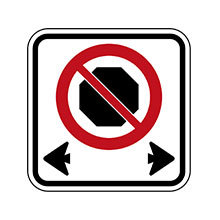 No Stopping
No Stopping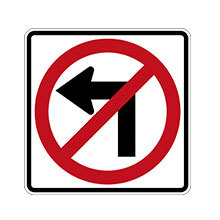 No Left Turn
No Left Turn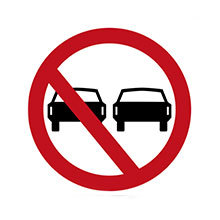 No Overtaking
No Overtaking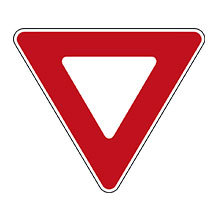 Yield
YieldYou will not see a common maximum speed sign in Canada, contrarily to some other countries. The maximal speed sign is usually rectangular, with a black writing on a white background.
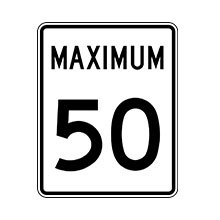 Maximum Speed Limit
Maximum Speed LimitMost Canadian warning signs are diamond-shaped with black lettering or symbols on a yellow background.
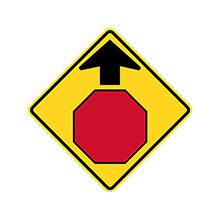 Stop Ahead
Stop Ahead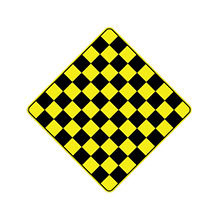 Dead End
Dead End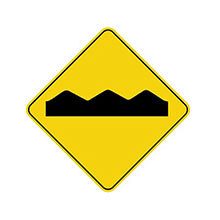 Bump or Uneven pavement on the Road Ahead
Bump or Uneven pavement on the Road Ahead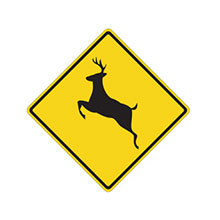 Be Alert for Animals
Be Alert for Animals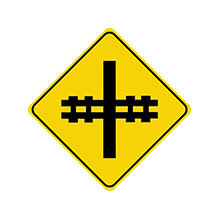 Railway Crossing Ahead
Railway Crossing AheadIn Canada, information signs show where you are, what road you are driving on or how to reach certain places. These signs normally feature a rectangular shape with green or blue background.
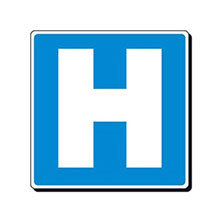 Hospital Nearby
Hospital Nearby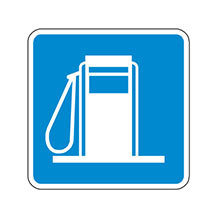 Gas Available Ahead
Gas Available Ahead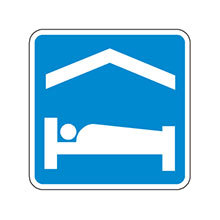 Accommodation Ahead
Accommodation AheadAs for directional signs, they are usually rectangular with a green background, and inform drivers about the direction or distance in kilometres to neighboring towns and cities.
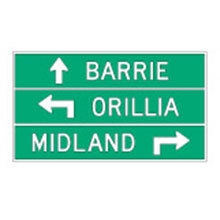 Directions to Nearby Towns and Cities
Directions to Nearby Towns and Cities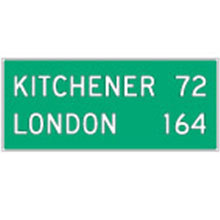 Distances in Kilometres to Towns and Cities on the Road
Distances in Kilometres to Towns and Cities on the RoadYou may refer to this complete manual of standard Canada traffics signs and pavement markings for a better knowledge.
Seatbelt and Child Safety
 Seatbelt Laws
Seatbelt LawsAs for seatbelt law, every Canadian province makes it compulsory for the driver and all passengers to wear seatbelts whilst the car is moving. Failing to do so will result in a fine that varies according to the province.
 Booster Seat Laws
Booster Seat LawsChildren of 8 years old and under must be properly secured in a child seat restraint system until they are at least 145 cm tall or 36 kg. Children who weigh less than 9 kg must be secured in a rear-facing car seat.
Age and other requirements vary by Canadian province or territory. You may use this as a reference or an idea for the child safety laws when travelling with your kids in Canada, but it is advisable for you to check individual provincial rules before you set for the road.
Parking, Fuel and Toll
 Parking
ParkingParking regulations vary across provinces and territories and are normally the responsibility of municipalities. But you do not need to worry as signage states clearly for the permitted and forbidden parking on all streets.
· Permitted Parking
Street parking is usually only permitted in the direction of traffic. In some smaller roads, parking is only allowed on one side of the road.
Plenty of car parks are available in most of the cities. Prices vary greatly from one city to another and can be very high in cities like Vancouver. Parking can be paid by a ticket machine, a metre at the side of the road, or by a parking attendant at a public parking lot. Failing to pay for parking in these areas may result in a fine.
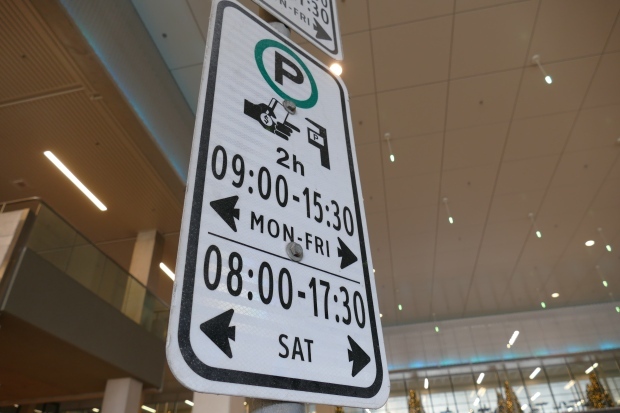 (Image from i.cbc.ca)
(Image from i.cbc.ca)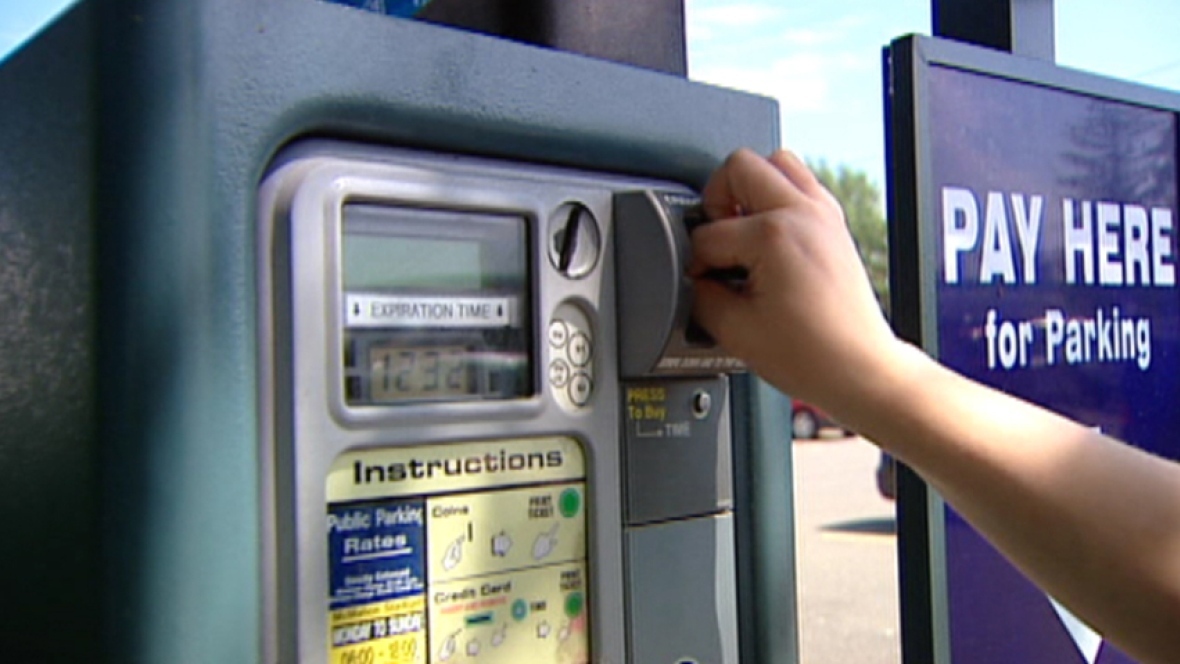 (Image from cbc.ca)
(Image from cbc.ca)· No Parking
Street parking in some residential areas is not allowed in the winter. There are signs indicating when parking is not allowed.

 Fuel Prices
Fuel PricesThe average price for Canada gasoline price in January 2018 is 1.36 Canadian dollar, while diesel cost 1.01.
 Toll
TollThere are several toll roads in Canada such as The Ontario Highway 407 and The Cobequid Pass (Highway 104). All of the toll roads have utilized Electronic Toll Collection system.
 (Image from o.canada.com)
(Image from o.canada.com)If you are planning to drive on these toll roads, you can choose to opt into the e-toll system with your car hire company. Normally, the terms are stated in the rental contract provided by the car hire company at the rental desk. These terms should let you be aware that your credit card may be debited 4-8 weeks after you return the car. If you use an Alamo, National or Enterprise rental car, it is advisable to go to check with the Highway Toll Administration site to find out the details of the toll collected.
You are always welcomed to reach out to QEEQ' 24/7 customer service team for assistance or clarifications in matter regarding tolling.
Traffic Violation
 DUI Laws
DUI LawsCanada has very strict laws on drunk driving. The limit is the same as in the UK which is 80mg per 100ml of blood but lowered to 50mg in some provinces. If you already have a drink driving conviction on your licence within the last five years, you will be refused entering at the Canadian point of entry.
Punishment varies by provinces but all are treated very seriously. The minimum punishment for a first offence is a $1000 fine and a year's licence suspension.
 Traffic Fines
Traffic FinesSpeeding in Canada can be fined from $100 to over $400 depending on provinces.
For the spot tickets, follow the instructions on the paper to proceed to the payment. It is advisable to pay fines directly when you are still in the city.
For tickets issued from cities of Toronto, Ottawa or Montreal, you can log in the city's website to check the details and pay for them by entering your ticket number( or plus with the licence plate number).
Driving Licence and Age Requirements
To legally rent and drive a car in Canada, you will need a driving licence issued by the government which has been held for at least 2 years. If your domestic driving licence is not in English, an International Driving Permit (IDP/IDL) or an official translation in English is required when you drive in Canada.
The minimum driver age for renting a car at a Canadian rental office is 21 years old. This age may vary according to the state and car category rented.
Leer más detalles
Las mejores ofertas de alquiler de coches en Canadá
Preguntas frecuentes
- Q1.¿Qué es la franquicia del seguro?La franquicia es el monto por el que será responsable en caso de daños (bajo Exención parcial por colisión) o robo (bajo Cobertura por robo) del coche.
La información sobre franquicia se indicará claramente en la inclusión de precios cuando reserve un automóvil en QEEQ. - Q2. ¿Cómo puedo aañadir un conductor adicional?Se recomienda realizar una solicitud al llegar al mostrador del alquiler. Podría incurrir en un cargo adicional por día a menos que "un conductor adicional" est'a estipulado en e contrato de alquiler.
Por favor, tenga en cuenta que los mismos requisitos de licenceia y edad aplican para el conductor adicional. El conductor adicional debe presentar la licencia requerida junto con el conductor principal a la hora de la recogida. - P3.¿Qué pasa si quiero hacer la recogida o devolución fuera de horarios de oficina?QEEQ le mostrará las ofertas de automóviles disponibles para las fechas que seleccionó en la barra de búsqueda.
Sin embargo, la recogida o devolución fuera de horarios del proveedor podría tener como consecuencia un cargo extra, a menos que cuente con la opción de autoservicio de recogida o devolución.
Después de reservar un automóvil en QEEQ, le informaremos por correo electrónico de la política específica de la agencia de alquiler de automóviles. - Q4. ¿Puedo ir a otro país o cruzar la frontera con el coche que alquilé?Si desea recoger su automóvil en un país y devolverlo en otro, los resultados de su búsqueda le mostrarán automóviles con los que puede hacerlo.
Si planea cruzar cualquier frontera durante su viaje, tenga en cuenta que:
1. Es posible que tenga que pagar más.
A menudo hay cuotas, impuestos o coberturas adicionales que pagará en el mostrador de alquiler de coches.
2. Cruzar la frontera podría estar prohibido.
Dependiendo de dónde alquile, es posible que no pueda llevar su automóvil a otro país.
Envíenos un correo electrónico si desea llevar su coche de alquiler a un país diferente durante su viaje, y le diremos cuáles son las opciones. - P5.- ¿Puedo recoger un automóvil en un lugar y devolverlo en otro?Sí. Puede recoger el automóvil en un lugar y devolverlo en otro. Incurrirá en una tasa de "trayecto de sólo ida". Si esta tasa está incluida en el precio de alquiler, o si por el contrario es un costo adicional, será indicado claramente en el momento de reservar con QEEQ.
Cuando recoja el coche, por favor informe su lugar de devolución directamente a la agencia de alquiler de automóviles, o comuníquese con ellos durante su viaje. Encontrará su número de teléfono en el contrato de alquiler que firmó al recoger el coche.
¿Tiene alguna pregunta? Simplemente visite nuestra página de ayuda .
Explore más destinos en Canadá
Our Advantages
Suscríbete para ofertas y promociones exclusivas
Por favor, introduce una dirección de correo electrónico válida


 Stop Sign (French and English)
Stop Sign (French and English) Stop Sign (Inuktitut and English)
Stop Sign (Inuktitut and English) Stop sign (Cree)
Stop sign (Cree) No Stopping
No Stopping No Left Turn
No Left Turn No Overtaking
No Overtaking Yield
Yield Maximum Speed Limit
Maximum Speed Limit Stop Ahead
Stop Ahead Dead End
Dead End Bump or Uneven pavement on the Road Ahead
Bump or Uneven pavement on the Road Ahead Be Alert for Animals
Be Alert for Animals Railway Crossing Ahead
Railway Crossing Ahead Hospital Nearby
Hospital Nearby Gas Available Ahead
Gas Available Ahead Accommodation Ahead
Accommodation Ahead Directions to Nearby Towns and Cities
Directions to Nearby Towns and Cities Distances in Kilometres to Towns and Cities on the Road
Distances in Kilometres to Towns and Cities on the Road


 (Image from i.cbc.ca)
(Image from i.cbc.ca) (Image from cbc.ca)
(Image from cbc.ca)


 (Image from o.canada.com)
(Image from o.canada.com)

